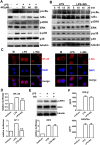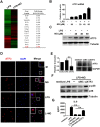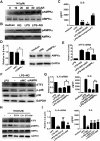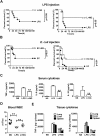The citrus flavonoid naringenin confers protection in a murine endotoxaemia model through AMPK-ATF3-dependent negative regulation of the TLR4 signalling pathway
- PMID: 28004841
- PMCID: PMC5177915
- DOI: 10.1038/srep39735
The citrus flavonoid naringenin confers protection in a murine endotoxaemia model through AMPK-ATF3-dependent negative regulation of the TLR4 signalling pathway
Abstract
Excessive activation of the TLR4 signalling pathway is critical for inflammation-associated disorders, while negative regulators play key roles in restraining TLR4 from over-activation. Naringenin is a citrus flavonoid with remarkable anti-inflammatory activity, but the mechanisms underlying its inhibition of LPS/TLR4 signalling are less clear. This study investigated the molecular targets and therapeutic effects of naringenin in vitro and in vivo. In LPS-stimulated murine macrophages, naringenin suppressed the expression of TNF-α, IL-6, TLR4, inducible NO synthase (iNOS), cyclo-oxygenase-2 (COX2) and NADPH oxidase-2 (NOX2). Naringenin also inhibited NF-κB and mitogen-activated protein kinase (MAPK) activation. However, it did not affect the IRF3 signalling pathway or interferon production, which upregulate activating transcription factor 3 (ATF3), an inducible negative regulator of TLR4 signalling. Naringenin was demonstrated to directly increase ATF3 expression. Inhibition of AMPK and its upstream calcium-dependent signalling reduced ATF3 expression and dampened the anti-inflammatory activity of naringenin. In murine endotoxaemia models, naringenin ameliorated pro-inflammatory reactions and improved survival. Furthermore, it induced AMPK activation in lung tissues, which was required for ATF3 upregulation and the enhanced anti-inflammatory activity. Overall, this study reveals a novel mechanism of naringenin through AMPK-ATF3-dependent negative regulation of the LPS/TLR4 signalling pathway, which thereby confers protection against murine endotoxaemia.
Figures








Similar articles
-
Protective effect of naringenin against experimental colitis via suppression of Toll-like receptor 4/NF-κB signalling.Br J Nutr. 2013 Aug;110(4):599-608. doi: 10.1017/S0007114512005594. Epub 2013 Mar 18. Br J Nutr. 2013. PMID: 23506745 Free PMC article.
-
Interactions of TLR4 and PPARγ, Dependent on AMPK Signalling Pathway Contribute to Anti-Inflammatory Effects of Vaccariae Hypaphorine in Endothelial Cells.Cell Physiol Biochem. 2017;42(3):1227-1239. doi: 10.1159/000478920. Epub 2017 Jul 3. Cell Physiol Biochem. 2017. PMID: 28683454
-
Naringenin attenuates the release of pro-inflammatory mediators from lipopolysaccharide-stimulated BV2 microglia by inactivating nuclear factor-κB and inhibiting mitogen-activated protein kinases.Int J Mol Med. 2012 Jul;30(1):204-10. doi: 10.3892/ijmm.2012.979. Epub 2012 Apr 23. Int J Mol Med. 2012. PMID: 22552813
-
Pharmacological Properties and Therapeutic Potential of Naringenin: A Citrus Flavonoid of Pharmaceutical Promise.Curr Pharm Des. 2016;22(28):4341-59. doi: 10.2174/1381612822666160530150936. Curr Pharm Des. 2016. PMID: 27238365 Review.
-
Naringenin as a potential immunomodulator in therapeutics.Pharmacol Res. 2018 Sep;135:122-126. doi: 10.1016/j.phrs.2018.08.002. Epub 2018 Aug 3. Pharmacol Res. 2018. PMID: 30081177 Review.
Cited by
-
Dietary Naringenin Preserves Insulin Sensitivity and Grip Strength and Attenuates Inflammation but Accelerates Weight Loss in a Mouse Model of Cancer Cachexia.Mol Nutr Food Res. 2021 Nov;65(22):e2100268. doi: 10.1002/mnfr.202100268. Epub 2021 Sep 27. Mol Nutr Food Res. 2021. PMID: 34499400 Free PMC article.
-
Neutrophil heterogeneity and plasticity: unveiling the multifaceted roles in health and disease.MedComm (2020). 2025 Jan 21;6(2):e70063. doi: 10.1002/mco2.70063. eCollection 2025 Feb. MedComm (2020). 2025. PMID: 39845896 Free PMC article. Review.
-
Dysregulation of Lipid Metabolism in Macrophages Is Responsible for Severe Endotoxin Tolerance in FcgRIIB-Deficient Lupus Mice.Front Immunol. 2020 Jun 9;11:959. doi: 10.3389/fimmu.2020.00959. eCollection 2020. Front Immunol. 2020. PMID: 32582149 Free PMC article.
-
Acute exposure to polystyrene nanoparticles promotes liver injury by inducing mitochondrial ROS-dependent necroptosis and augmenting macrophage-hepatocyte crosstalk.Part Fibre Toxicol. 2024 Apr 12;21(1):20. doi: 10.1186/s12989-024-00578-6. Part Fibre Toxicol. 2024. PMID: 38610056 Free PMC article.
-
The Therapeutic Potential of Naringenin: A Review of Clinical Trials.Pharmaceuticals (Basel). 2019 Jan 10;12(1):11. doi: 10.3390/ph12010011. Pharmaceuticals (Basel). 2019. PMID: 30634637 Free PMC article. Review.
References
-
- Akira S. & Takeda K. Toll-like receptor signalling. Nat Rev Immunol 4, 499–511 (2004). - PubMed
-
- Broz P. & Monack D. M. Newly described pattern recognition receptors team up against intracellular pathogens. Nat Rev Immunol 13, 551–565 (2013). - PubMed
-
- Mills K. H. TLR-dependent T cell activation in autoimmunity. Nat Rev Immunol 11, 807–822 (2011). - PubMed
-
- Gay N. J., Symmons M. F., Gangloff M. & Bryant C. E. Assembly and localization of Toll-like receptor signalling complexes. Nat Rev Immunol 14, 546–558 (2014). - PubMed
Publication types
MeSH terms
Substances
LinkOut - more resources
Full Text Sources
Other Literature Sources
Research Materials
Miscellaneous

